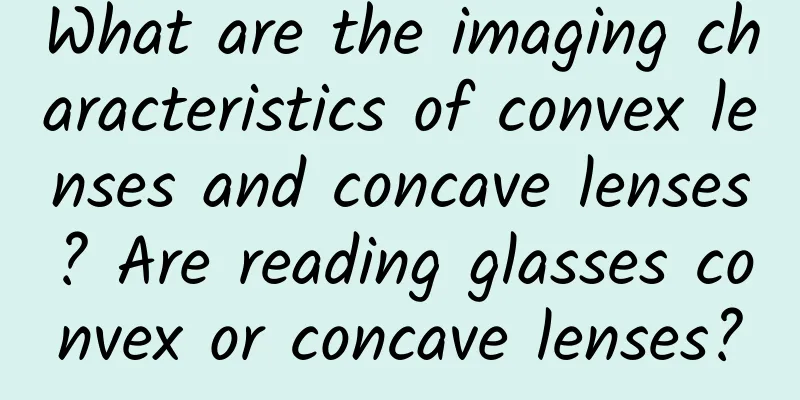What are the imaging characteristics of convex lenses and concave lenses? Are reading glasses convex or concave lenses?

|
There are many daily necessities in life that use the imaging characteristics of convex lenses and concave lenses, such as cameras, projectors, movies, magnifying glasses, etc., while concave and convex lenses are mainly used in myopia glasses, table lamps, radars, flashlights, etc. It is also very common. What are the imaging characteristics of convex lenses and concave lenses? Let's take a look! Contents of this article 1. What are the imaging characteristics of convex lenses and concave lenses? 2. Are reading glasses convex or concave lenses? 3. Why does a convex lens form a reduced image when the object distance is greater than 2F? 1What are the imaging characteristics of convex and concave lenses?There are three types of imaging characteristics of convex lenses, namely, inverted and reduced real image, inverted and equal-sized real image, and inverted and enlarged real image. The imaging characteristic of concave lens is that when the object is solid, it forms an erect and reduced virtual image, and the image and the object are on the same side of the lens. To understand the imaging characteristics of convex and concave lenses, we need to understand what they are. Convex lenses are also called positive spherical lenses. They are thick in the middle and thin at the edges. They are convex in shape and have a convergent effect on light. Concave lenses are also called negative spherical lenses. They are thin in the middle and thick at the edges. They are concave in shape and have a divergent effect on light. Convex lenses refract images, and the images they form include inverted, reduced real images, inverted, equal-sized real images, inverted, magnified real images, etc. The imaging rule of concave lenses is that when the object is solid, an upright, reduced virtual image is formed, and the image and the object are on the same side of the lens. 2Are reading glasses convex or concave lenses?Reading glasses are a type of convex lens. You can determine whether the reading glasses are convex or concave lenses by analyzing the lens thickness and imaging method, and what preparations you need to make before purchasing suitable reading glasses. First, analyze the thickness of the lenses of the reading glasses. If it is thick in the middle and thin at the edges, it is a convex lens, which has the effect of a magnifying glass, but it is not the same as a magnifying glass. The function of reading glasses is not only to see the words clearly, but also to maintain the vision of the elderly and ensure that the vision will not continue to decline, which has the function of protecting the eyes. Secondly, according to the imaging method in physics, the convex lens has the function of magnifying objects. Put a newspaper on the table, and then use the lens to observe the words on the newspaper. If the words are magnified, it is a convex lens, otherwise it is a concave lens. Before wearing reading glasses, it is best to go to the hospital for an eye test, just like a tailor who has to measure the customer's height, waist circumference and weight before making a custom-made garment. Presbyopia is a normal physiological phenomenon as the body ages. The lens in the eye also weakens its ability to adjust vision as it ages. Wearing reading glasses is also to make the daily life of the elderly more convenient. 3Why does a convex lens form a reduced image when the object distance is greater than 2F?Because convex lenses have thickness, optical devices in junior high school physics basically do not take thickness into account, but they cannot work without thickness, which leads to seemingly anti-physical phenomena in life. At this time, the object should be near the focus of the convex lens, so there will be this double imaging situation. There is both an upright and enlarged virtual image of the object within one focal length, and an inverted and enlarged real image, and they happen to be imaged at the same position. The object is at 2 times the focal length, forming an inverted real image of the same size. At this time, the object distance and image distance are both 2 times the focal length, and the sum of the object distance and image distance is 4f. When the object is at 1 times the focal length, the object distance is 1 times the focal length. At this time, according to the object-image formula, it can be concluded that the image is at infinity, that is, the image distance is infinity, which is much larger than the sum of the object distance and image distance in the first case. |
>>: What does the focal length of a convex lens relate to? What is the definition of a convex lens?
Recommend
What is the route from Dunhuang to Tibet? What are the similarities and differences between the Kham Tibetans and the Tibetans in Tibet?
In the sixth year of the Zhenguan Period of the T...
I never thought that these things that we use every day are dirtier than toilets! How can we clean them more effectively?
Wake up to the alarm in the morning Fingers flyin...
Pregnant women should "move" to stay away from venous thrombosis
Pregnant women should "move" to stay aw...
Can pregnant women eat prunes? Do you know these benefits?
Pregnant women can eat prunes, but it is recommen...
Does it hurt for women to have their fallopian tubes opened?
There are many women who have difficulty getting ...
Is 1.2cm endometrial thickness within normal range?
In modern society, the thickness of the endometri...
What are the maintenance methods for women in their forties?
It is said that men are in their prime at 41, whi...
Can I use the pills during ovulation?
Can vaginal suppositories be used during ovulatio...
Why do shrimp crackers expand when fried? Why do shrimp crackers expand when fried?
We all know that shrimp chips are a common food i...
What are the symptoms of abnormal leucorrhea?
Abnormal leucorrhea is a common symptom caused by...
What should I do if my menstruation keeps coming early?
Some women have problems with their menstruation,...
As the Great Heat arrives, what should you pay attention to in order to maintain your health?
Today is July 22, 2024. Monday, June 17, Jiachen ...
Abdominal pain four days after abortion
As people's minds gradually open up, some wom...
What to do if a pregnant woman gets angry? How to reduce the fire
If the temperature is too dry, many people are li...
Yang Lihua answers questions: 33% of parents believe that their children’s vision has deteriorated during the epidemic. How to delay myopia?
Recently, under the guidance of the Department of...









